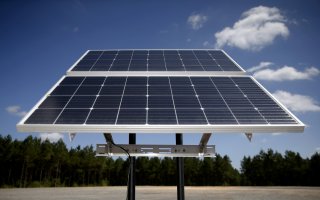Solar Power: The U.S. Military Wants to Harvest the Sun's Energy
It would power objects on Earth using a gigantic array of solar panels.
Here's What You Need to Know: It remains to be seen if this project will be feasible.
In a May 2020 press release, the Department of Defense explained the United States Space Force will be using the X-37B reusable space plane in the future for conducting experiments in space. The report detailed a rather bland experiment involving the effects of radiation from space on seeds—not exactly an attention-grabber.
It then casually and quietly mentioned how the Naval Research Laboratory is planning to harvest the sun’s energy for use on Earth. “A third experiment, designed by the Naval Research Laboratory, transforms solar power into radiofrequency microwave energy, then studies transmitting that energy to Earth,” the press release said.
Essentially the X-37B will carry an array of solar panels that can be deployed once the space plane is in orbit around the Earth. Once stretched out, these panels could gather soar energy from the Sun and send it back down to Earth.
High in the Sky
If a workable design is created, this solar energy gatherer could harvest enormous amounts of energy, at much greater efficiency than Earth-side solar arrays. The anticipated jump in efficiency would be thanks to the conditions in space—cloud cover wouldn’t be a problem and dust would likely cover the panels only very lightly, if at all.
Harvested solar energy would then be beamed back to Earth in the form of microwaves. Microwaves could be used to power a variety of equipment, possibly even onto any location on Earth. The energy harvesting system could be used to provide emergency power to crisis-stricken areas—and there is also a military application, of course.
Troops at remote outposts or inaccessible locations could in theory be provided with a powerful, unlimited supply of energy. With an effective delivery system, it may have the potential to virtually eliminate some types of energy supply lines, like fuel for trucks, tanks, or other vehicles.
Additionally, solar energy could also be used to power objects in orbit, like space stations, space aircraft, or even other satellites.
Challenges
There are a couple of obstacles to overcome though. Dr. Paul Jaffe, an aerospace engineer with the U.S. Naval Research Laboratory explained that one of the non-material difficulties is simple physics—it is expensive to launch things into space. And the heavier an object is, the more propellent it needs to get airborne, and the bigger the price tag gets. In order to keep weight to a minimum, internal components would need to be made as small and light as possible, itself not an easy engineering feat.
The other issue is not specific to the solar harvesting concept, but to all satellites in general. Once aloft, satellites orbit the Earth at incredible speeds. Getting them into a different orbit for directing energy elsewhere on Earth is challenging. It remains to be seen if this project will be feasible, costs and technical difficulties aside.
Caleb Larson holds a Master of Public Policy degree from the Willy Brandt School of Public Policy. He lives in Berlin and writes on U.S. and Russian foreign and defense policy, German politics, and culture.
This article first appeared in May 2020.
Image: REUTERS/Jonathan Bachman

